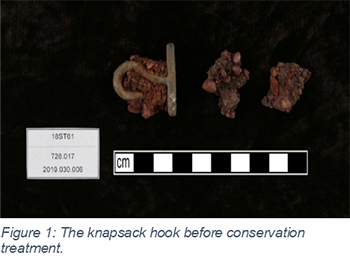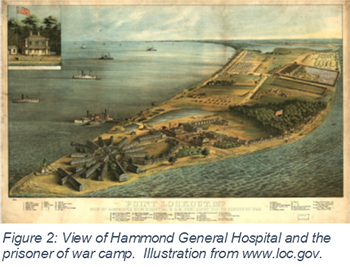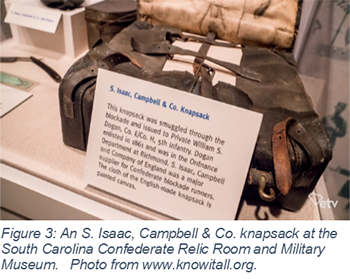Curator's Choice 2020
“The Load I Carry”: A Knapsack Hook from Pt. Lookout
By Heather Rardin Rovardi, Conservator
 Point Lookout State Park is situated a little over 45 miles south of the Maryland Archaeological Conservation Laboratory. From 2017 to 2018, EAC/Archaeology conducted fieldwork near the lighthouse and found a number of 19th-century artifacts that offered a glimpse into the Civil War era and the role that Point Lookout played in the conflict. Among the artifacts found east of the lighthouse was a copper alloy J-hook (see Figure 1), which archaeologists identified as belonging to a knapsack (Wanner 2020).
Point Lookout State Park is situated a little over 45 miles south of the Maryland Archaeological Conservation Laboratory. From 2017 to 2018, EAC/Archaeology conducted fieldwork near the lighthouse and found a number of 19th-century artifacts that offered a glimpse into the Civil War era and the role that Point Lookout played in the conflict. Among the artifacts found east of the lighthouse was a copper alloy J-hook (see Figure 1), which archaeologists identified as belonging to a knapsack (Wanner 2020).

The 19th century proved to be eventful for Point Lookout. A lighthouse was built there in 1830, and in 1857 William Cost Johnson purchased 400 acres for the purpose of building a resort. The resort was a success until Johnson’s death in 1860. In 1862, Hammond General Hospital (see Figure 2) was built, and in the following year a prisoner of war camp was established to hold captured Confederates (Gottfried and Gottfried 2018).
Both Union and Confederate soldiers were outfitted with knapsacks, which they would have used to carry extra food, blankets, and spare clothing. The average knapsack, when full, would have weighed between 30 and 40 pounds. Quality varied among Confederate knapsacks and seems to have depended on what a soldier’s family could afford or what a soldier himself could steal. Some soldiers chose to forgo the knapsack entirely and carried their belongings in rolled-up blankets. Among the better quality knapsacks available to Confederate soldiers were those made by S. Isaac, Campbell & Co. (Axelrod 2017:99, 108). EAC/Archaeology staff identified the J-hook from the Point Lookout excavations as belonging to a knapsack from this same manufacturer (Wanner 2020).
 S. Isaac, Campbell & Co. was a firm based in London and run by two brothers, Saul and Samuel. The firm was a supplier to the British army, but it entered into a supply contract with the Confederacy as the CSA sought out new ways to keep pace with the Union. The knapsacks manufactured by S. Isaac, Campbell & Co. boasted waterproof fabric, wooden frames, and more comfortable over-the-shoulder straps (Axelrod 2017:99). The main compartment was secured shut by several straps, and the closed flap would face the soldier’s back instead of outward (South Carolina Confederate Relic Room & Military Museum 2020). An example of one that has survived can be seen in Figure 3.
S. Isaac, Campbell & Co. was a firm based in London and run by two brothers, Saul and Samuel. The firm was a supplier to the British army, but it entered into a supply contract with the Confederacy as the CSA sought out new ways to keep pace with the Union. The knapsacks manufactured by S. Isaac, Campbell & Co. boasted waterproof fabric, wooden frames, and more comfortable over-the-shoulder straps (Axelrod 2017:99). The main compartment was secured shut by several straps, and the closed flap would face the soldier’s back instead of outward (South Carolina Confederate Relic Room & Military Museum 2020). An example of one that has survived can be seen in Figure 3.
What became of the man who brought the S. Isaac, Campbell & Co. knapsack with him to Point Lookout? We may never know for certain. Even if his better-constructed knapsack was an indicator of wealth and status in his former life, his valuables (including perhaps the knapsack) would have been confiscated upon entry to Point Lookout, and the value of these goods would have generated credit for him as currency on the prison grounds (Beitzell 1972: 113). He would have been crammed into a tent that he would share with other men, with little to no spare clothing, brackish water to drink, and scant meals (Gottfried and Gottfried 2018:31, Beitzell 1972:183).
During his visit to Point Lookout in November of 1863, Dr. Swalm of the U.S. Sanitary Commission described a scene of “men of all ages and classes, descriptions and hues, with various colored clothing, all huddled together, forming a motley crew” (Gottfried and Gottfried 2018:32).
References |
| Axelrod, Alan |
2017
|
Armies South, Armies North. Lyons Press, Lanham.
|
| |
Beitzell, Edwin W.
|
| 1972 |
Point Lookout Prison Camp for Confederates. Abell, published by the author.
|
| |
Gottfried, Bradley M. and Gottfried, Linda I.
|
2018
|
Hell Comes to Southern Maryland: the story of Point Lookout Prison and Hammond General Hospital. Fairfield, Turning Point Publishing.
|
South Carolina Confederate Relic Room & Military Museum
|
| 2020 |
S. Isaac, Campbell & Co. Backpack. South Carolina Confederate Relic Room & Military Museum: Educational Videos. Video accessed on September 22, 2020 at https://youtu.be/21CrhINPRrc. |
| |
Wanner, Rob
|
2020
|
“A bleak, barren sand beach”: Recent Investigations at Point Lookout Light Station. Maryland Historical Trust and Archeological Society Maryland 2020 “Virtual” Workshop in Archeology. Web presentation accessed August 20, 2020 at https://youtu.be/rR1y0KhikCY.
|
| |